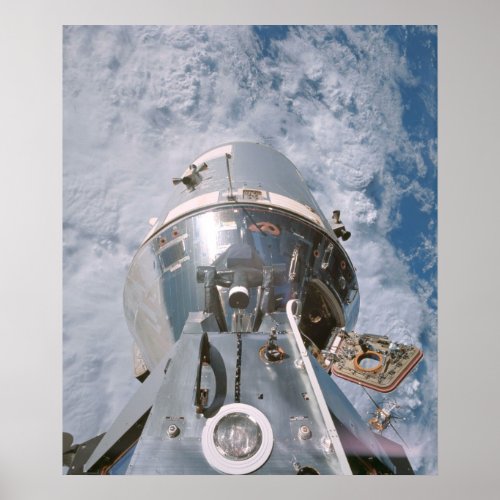Apollo 9 Command Module docked with Lunar Module Poster



The primary objective of Apollo 9 was an Earth-orbital engineering test of the first crewed lunar module, or LM. Concurrent prime objectives included an overall checkout of launch vehicle and spacecraft systems, the crew, and procedures. This was done by performing an integrated series of flight tasks with the command module, or CM, the service module, or SM, the joined command and service module, or CSM, the LM and S-IVB stage while they were linked in launch or various docked configurations, and while they were flying separate orbital patterns. The LM was to be tested as a self-sufficient spacecraft, and was also to perform active rendezvous and docking maneuvers paralleling those scheduled for the following Apollo 10 lunar-orbit mission. The flight plan's top priority was the CSM and LM rendezvous and docking. This was performed twice -- once while the LM was still attached to the S-IVB, and again when the LM was active. Further goals included internal crew transfer from the docked CSM to the LM; special tests of the LM's support systems; crew procedures; and tests of flight equipment and the extravehicular activity, or EVA, mobility unit. The crew also configured the LM to support a two-hour EVA, and simulated an LM crew rescue, which was the only planned EVA from the LM before an actual lunar landing. The LM descent and ascent engines fired on orbital change patterns to simulate a lunar-orbit rendezvous and backup abort procedures. The CSM service propulsion system, or SPS, fired five times, including a simulation of an active rendezvous to rescue an LM that had become inactivate. After separation of the CSM from the SLA in Earth orbit and jettison of the SLA's LM protective panels, the CSM was to transpose position and dock with the exposed LM. The docked modules were to separate and the spacecraft was to adjust its orbit 2,000 feet away from the S-IVB stage. The S-IVB engine was then to restart twice, placing the stage in an Earth-escape trajectory and into solar orbit. This would simulate a translunar injection of the stage for Apollo 10 and subsequent lunar missions. Other objectives included the multi-spectral photographic experiment for subsequent crewed spacecraft. All prime mission objectives were met. All major spacecraft systems were successfully demonstrated. The few off-nominal conditions that developed did not affect achievement of the major goals.


